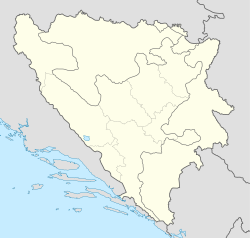파보니스자리 엡실론
Epsilon Pavonis| 관찰 데이터 Epoch J2000 Equinox J2000 | |
|---|---|
| 콘스텔레이션 | 파보 |
| 적경 | 20h 00m 35.55558s[1] |
| 적위 | -72°54°37.8198°[1] |
| 겉보기 등급(V) | 3.97[2] |
| 특성. | |
| 스펙트럼형 | A0Va[2] |
| U-B 색지수 | - 0.05[3] |
| B-V 색지수 | - 0.03[2] |
| 아스트로메트리 | |
| 반지름 속도(Rv) | - 6.7±0.7km[4]/s |
| 고유운동(μ) | RA: +81.78[1] mas/년 Dec.: - 802.16mas[1]/년 |
| 시차()) | 31.04 ± 0.17 mas[1] |
| 거리 | 105.1 ± 0.6 리 (32.2 ± 0.2 pc) |
| 절대 등급(MV) | 1.43[2] |
| 세부 사항 | |
| 덩어리 | 2.2[5] M☉ |
| 반지름 | 1.74[6] R☉ |
| 광도 | 32개[7] |
| 표면 중력(log g) | 4.32±0.02[6] CGS |
| 온도 | 10,440[8] K |
| 회전 속도(v sin i) | 85[7] km/s |
| 나이 | 27[6] 미르 |
| 기타 명칭 | |
| 데이터베이스 참조 | |
| 심바디 | 데이터. |
파보니스자리 엡실론은 파보자리에 있는 흰색 빛을 띤 단일 [9]별이다.겉보기 등급은 3.[2]97로 육안으로 볼 수 있다.31.04ms의 연간[1] 시차 편이는 태양으로부터 105광년 떨어진 거리 추정치를 제공한다.이 별은 IC 2391 [10]성단과 관련된 60개 이상의 젊은 별들로 이루어진 젊은 운동성단인 Argus 성협의 구성원이다.엡실론 [4]파보니스는 초속 6.7km의 속도로 태양에 가까워지고 있다.
파보니스자리 [2]엡실론은 A0 Va의 항성분류로 중심핵에서 수소융합을 통해 에너지를 생성하는 일반적인 A형 주계열성이다.그것은[6] 불과 2700만년 전으로 추정 회전 속도는 85km/s이다[7].이 별의 질량은 태양의 2.2배이며[5] 반지름은 1.74입니다[6].이 행성은 유효 온도 10,440 [8]K의 광구에서 태양의 32배의 광도를 방출하고[7] 있습니다.
레퍼런스
- ^ a b c d e f Van Leeuwen, F. (2007). "Validation of the new Hipparcos reduction". Astronomy and Astrophysics. 474 (2): 653–664. arXiv:0708.1752. Bibcode:2007A&A...474..653V. doi:10.1051/0004-6361:20078357. S2CID 18759600. Vizier 카탈로그 엔트리
- ^ a b c d e f Anderson, E.; Francis, Ch. (2012). "XHIP: An extended hipparcos compilation". Astronomy Letters. 38 (5): 331. arXiv:1108.4971. Bibcode:2012AstL...38..331A. doi:10.1134/S1063773712050015. S2CID 119257644. Vizier 카탈로그 엔트리
- ^ Mermilliod, J. C. (2006). "VizieR Online Data Catalog: Homogeneous Means in the UBV System (Mermilliod 1991)". VizieR On-line Data Catalog: II/168. Originally Published in: Institut d'Astronomie. 2168. Bibcode:2006yCat.2168....0M.Vizier 카탈로그 엔트리
- ^ a b Gontcharov, G. A. (2006). "Pulkovo Compilation of Radial Velocities for 35 495 Hipparcos stars in a common system". Astronomy Letters. 32 (11): 759–771. arXiv:1606.08053. Bibcode:2006AstL...32..759G. doi:10.1134/S1063773706110065. S2CID 119231169.
- ^ a b Tetzlaff, N.; Neuhäuser, R.; Hohle, M. M. (2011). "A catalogue of young runaway Hipparcos stars within 3 kpc from the Sun". Monthly Notices of the Royal Astronomical Society. 410 (1): 190–200. arXiv:1007.4883. Bibcode:2011MNRAS.410..190T. doi:10.1111/j.1365-2966.2010.17434.x. S2CID 118629873. Vizier 카탈로그 엔트리
- ^ a b c d e Gerbaldi, M.; et al. (June 1999), "Search for reference A0 dwarf stars: Masses and luminosities revisited with HIPPARCOS parallaxes", Astronomy and Astrophysics Supplement, 137 (2): 273–292, Bibcode:1999A&AS..137..273G, doi:10.1051/aas:1999248.
- ^ a b c d Zorec, J.; Royer, F. (2012). "Rotational velocities of A-type stars". Astronomy & Astrophysics. 537: A120. arXiv:1201.2052. Bibcode:2012A&A...537A.120Z. doi:10.1051/0004-6361/201117691. S2CID 55586789. Vizier 카탈로그 엔트리
- ^ a b David, Trevor J.; Hillenbrand, Lynne A. (2015). "The Ages of Early-Type Stars: Strömgren Photometric Methods Calibrated, Validated, Tested, and Applied to Hosts and Prospective Hosts of Directly Imaged Exoplanets". The Astrophysical Journal. 804 (2): 146. arXiv:1501.03154. Bibcode:2015ApJ...804..146D. doi:10.1088/0004-637X/804/2/146. S2CID 33401607. Vizier 카탈로그 엔트리
- ^ Eggleton, P. P.; Tokovinin, A. A. (2008). "A catalogue of multiplicity among bright stellar systems". Monthly Notices of the Royal Astronomical Society. 389 (2): 869. arXiv:0806.2878. Bibcode:2008MNRAS.389..869E. doi:10.1111/j.1365-2966.2008.13596.x. S2CID 14878976.
- ^ Zuckerman, B.; et al. (May 2011). "The Tucana/Horologium, Columba, AB Doradus, and Argus Associations: New Members and Dusty Debris Disks". The Astrophysical Journal. 732 (2): 19. arXiv:1104.0284. Bibcode:2011ApJ...732...61Z. doi:10.1088/0004-637X/732/2/61. S2CID 62797470. 61.



